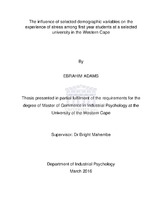| dc.description.abstract | The acceptance into university is particularly more challenging than gaining admission into primary and secondary institutions of learning. This is due to inter alia the limited amount of enrolment positions available at universities in relation to the number of students who complete their studies at secondary institutions. First year students experience a great change in curriculum from secondary school to tertiary education. These students experience a great deal of stress in terms of dealing with their new academic demands and their personal physiological developmental milestones. It is at this time that the students are fighting for the autonomy from the control of their parents or guardians as they strive to be independent. It is also at this stage that most students drop-out of tertiary education institutions. It is therefore important to understand how the demographic factors assist these students in dealing with stress. The purpose of the study was to answer the questionnaire, "Are there gender, age, home language, faculty and socioeconomic differences in the experience of stress among students at a selected tertiary institution in the Western Cape province of South Africa?" The research study was conducted using students from a university in the Western Cape Province of South Africa. The total number of respondents who completed the questionnaire was 306 (n= 306). The respondents comprised of only first year university students from various faculties. The participants in the study completed the SASS which comprised of 50 questions. In addition, they also completed a biographical section which comprised of the respondents' age, gender, home language, socio-economic status and faculty. An item analysis was conducted on the all of the SASS subscales (Affective, Behavioural, Cognitive and Physiological) using SPSS version 23. Subsequently, an Exploratory Factor Analysis (EFA) was performed on the subscales to ensure the uni-dimensionality of the subscales. A Pearson correlational test was performed to determine the relationship between age and stress since age was defined as a continuous variable. An independent samples t-test was conducted to determine if differences in mean scoresexist between gender and stress. An Analysis of variance (ANOVA) was performed to assess stress differences in terms of home language, socio-economic status and faculty. The analyses were performed using SPSS version 23. Based on the result we were able to conclude that there is no statistical significance between gender and stress; stress and language; socio-economic status and stress; as well as between faculty and stress. Furthermore, it was found that there is no significant relationship between age and stress. The practical implications of the study and limitations are discussed as well as the direction for future studies. | en_US |

